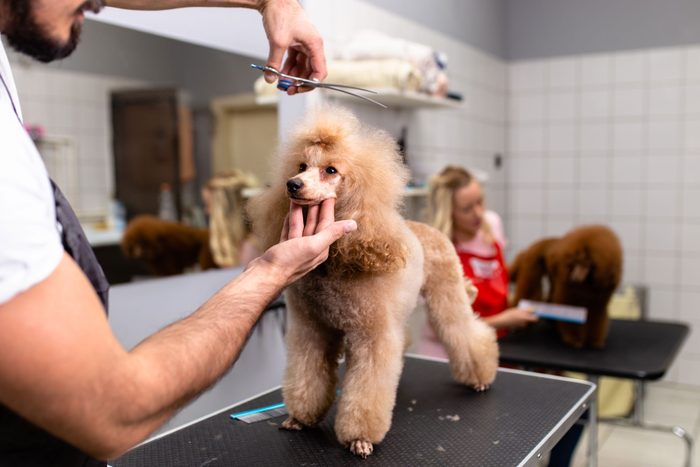
The do’s and don’ts of going to the groomer
Humans aren’t the only ones to leave a salon with a bad haircut. And unfortunately, our pets might suffer a similar fate if we don’t follow some standard etiquette rules, including establishing a mutually satisfying relationship with your pet’s groomer. But are all those good intentions causing more grief than joy? Maybe.
According to some pet groomers, there are certain “polite” things that customers do that actually make their job more difficult. These aren’t necessarily rude habits of dog owners; they tend to be well-intentioned acts that can just become annoying. We spoke to three professional groomers to get the lowdown on which “helpful” habits actually drive them nuts—and what to do instead. Here are some habits you might want to kick before your pet’s next grooming appointment.
Get Reader’s Digest’s Read Up newsletter for more pets, humor, travel, tech and fun facts all week long.
About the experts
|
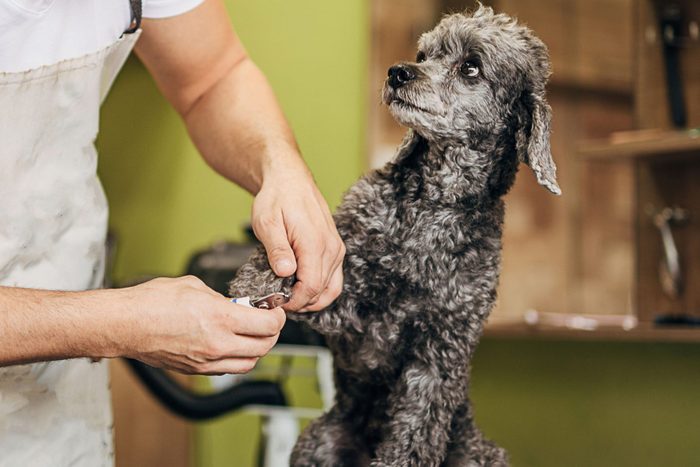
Downplaying your pet’s behavioral issues
“Out of politeness, many pet parents downplay their pet’s behavioral challenges during grooming sessions,” says Sabrina Kong, DVM, a veterinarian in Northern California and former dog groomer. Let’s say they were nippy and feisty when you attempted to groom your dog at home. You might chalk it up to inexperience. And because you don’t want to scare off a new groomer, you simply tell the groomer your pup may be a little nervous. “In reality, the pet has significant anxiety or aggression issues,” says Dr. Kong.
Do this instead: Be honest and spill the quirks and challenges you know about. “Sharing this openly allows groomers to prepare adequately and ensure a safe, stress-free experience for both the pet and the groomer. We can tailor our approach, use the right tools, and sometimes even allocate more time to accommodate these needs,” says Dr. Kong.
Over-apologizing for your pet’s appearance
You don’t want to come off as a neglectful pet parent, but there’s no need to be sorry. “Some pet parents excessively apologize for their pet’s condition, like matted fur or dirt, believing they’re burdening the groomer,” says Dr. Kong.
Do this instead: There’s no need to feel guilty. Groomers have seen it all, and it’s part of their job to tackle the dirtiest pets and matted dogs. “Rather than apologizing, explaining any circumstances leading to the pet’s current state is helpful. This context can be crucial for understanding the pet’s needs and providing the best care.”
Not specifying grooming preferences
As soon as you plop down into the chair, your hairdresser asks, “What would you like done today?” And you freeze. They make a suggestion you really don’t like, but you can’t bring yourself to say no. You just committed one of the polite habits hairdressers hate, and wouldn’t you know it, pet groomers feel the same way. “Pet parents often are reluctant to voice specific grooming requests, thinking they might be overstepping or asking too much,” says Dr. Kong.
Do this instead: Believe it or not, your groomer prefers to know what your preferences are for your pet, whether it is a specific haircut or how your pet likes to be handled. It ensures that you’re satisfied with the grooming outcome. “Sharing this information helps us personalize our service to your pet’s needs and your expectations and ensures that you’re satisfied with the grooming outcome,” Dr. Kong says.
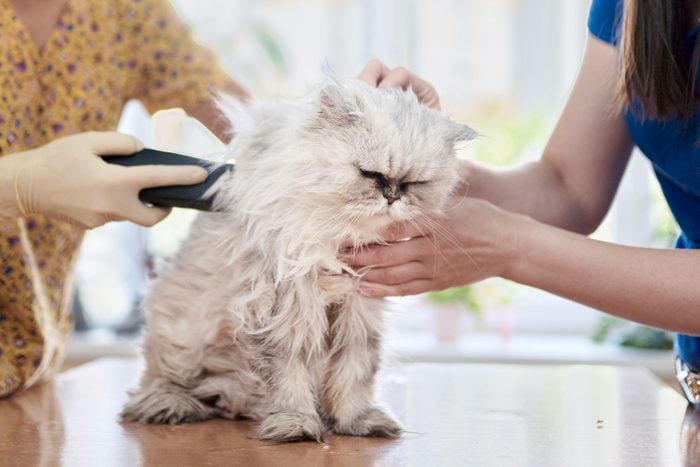
Offering to help
We’ll be the first to admit: Bathing a cat is hard. But just because your squirmy and persnickety Persian doesn’t let you bathe it without scratching and yowling, doesn’t mean your groomer can’t handle it. While it might seem nice to offer to stay and keep your cat calm, it’s not necessary.
Do this instead: Address these concerns upon booking and ask if there is a groomer on staff who is versed in handling nervous and anxious pets. “Better yet, if you know your pet has had challenges with things like nails or the blow-dryer, look for fear-free groomers or those who offer grooming rehab programs,” says Cassondra Smith, dog groomer and owner of Club Pawsh in Buffalo, New York.
Cutting out mats to help the groomer
Oh boy. Your dog grooming supplies haven’t seen the light of day in weeks, and your Maltese has some nasty matts. You want to keep its coat fluffy and long, so you cut out the mats to make it easier on the groomer. But you’ll want to think twice before doing that again.
Do this instead: “Believe it or not, unless you want a much shorter dog than originally planned, spot shaving or cutting mats out creates much more work for the groomer, especially if you want to keep length because we have to blend many different lengths,” says Smith. Try using dog conditioner on the mats at the base of the skin and work at them like you would loosen a tight ring on your finger. This could help the de-matting process go smoother and save some length on the fur.
Providing strict grooming instructions
It’s totally cool to have specific style preferences for your pet, but sometimes, other factors come into play, including the skill of the groomer, the type of hair or fur your pet has and ultimately, your pet’s cooperation, which can override even the most detailed written instructions.
Do this instead: “Check out the groomer’s portfolio of work on their social media and website to get an idea of the quality of work they do prior to booking to find out if they have the style you’re looking for,” says Smith. When you find a groomer that fits, talk to them about your grooming goals. Do you want a puppy cut now but a long and flowy one later? Would you prefer they clean your dog’s teeth in addition to the bath and haircut? Is a gentle touch necessary to clean your dog’s ears? Talk it out ahead of time so you’re both on the same page when it comes to expectations.
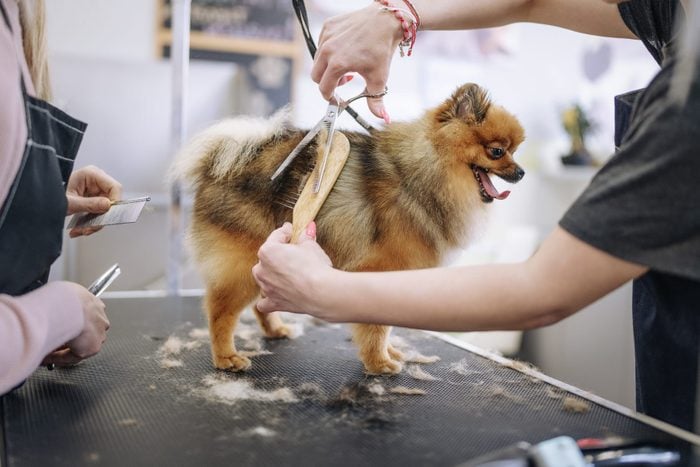
Interrupting while your pet is being groomed
In the neighborhood and want to stop by mid-groom to check in? Think again. It’s not great to show your face while your pet is having a spa day.
Do this instead: Whether you’re dropping off your pet at a grooming salon or walking them out to the mobile pet spa in your driveway, pass your pet on to the groomer and don’t come back until they’re ready. If your pet sees you after the grooming process has started, they’re going to be super psyched and start squirming and wiggling. After all, they love you—and you’re their ticket out of there! “Interrupting can be dangerous sometimes because grooming tools can be very sharp, and it can take a while for them to settle down again, which can make the groom take longer,” says Smith.
Sedating your dog without informing the groomer
If you think about it, going to the groomer is a lot like going to the doctor or the dentist. There are unfamiliar scents and sounds and people you don’t know getting awfully close with weird-looking tools. Anxious dogs and stressed-out cats might need a little sedation to get through the appointment.
Do this instead: Before you offer any sedative, check with your groomer to see if they take sedated pets. And here’s the important part: Know exactly when the sedative kicks in. “If using a mobile grooming service that gives arrival windows or a salon where dogs may wait in cages, be sure to communicate clearly to the groomer ahead of time what the specific time frame is for the sedative to kick in, how long it is expected to last and the main reasons they are on it—like fear of nails getting trimmed or the dryer,” says Smith. “We want to make sure we’re working on your dog when the sedative is actually working for the reasons they’re on it.”
Offering to bathe your dog at home to save time
Give yourself two paws up for knowing how often to bathe your dog at home. It’s not the easiest task, which is why some pet parents would rather do it at home and save the groomer some work. But your good intentions may actually mean more effort on the groomer’s part.
Do this instead: Grab a brush. “Brushing them out so a comb can run through without getting stuck just before their appointment would be fantastic!” says Smith. Groomers use different shampoos and conditioners depending on the type of hair, fur or skin conditions. Plus, there are specific blow-drying techniques that must be done to prepare for a quality haircut. So, towel drying at home could really tangle things up for the groomer.
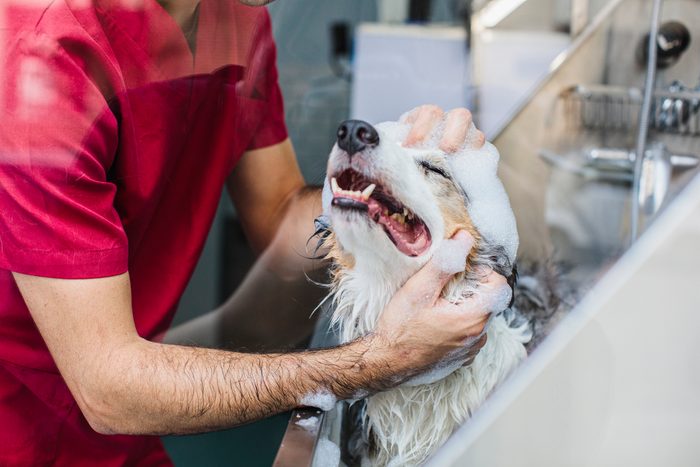
Asking the groomer to use your shampoo
We know. You’re just trying to be polite. And while you’re not crazy about the weird-smelling shampoo the groomer uses, giving them your own shampoo to use isn’t the best solution.
Do this instead: “If you have a particular shampoo you prefer, discuss it when booking to see if the salon carries it,” says Smith. Most at-home pet shampoos won’t give the same quality result as salon ones, just like when we go to the salon ourselves.” Not to mention: Some store-bought pet shampoos and conditioners can even be too harsh and muck up the skin’s delicate pH balance.
Saying, “Do whatever you think is best”
Not discussing grooming options isn’t a polite way to say, “I trust your judgment.” Although dog groomers appreciate the sentiment, it actually makes things more difficult. “We might have a completely different thought on the style and cut for a doodle, for example,” says Molly Bissantz, dog groomer and owner of Grooming by Molly in Boise, Idaho.
Do this instead: “Tell the groomer the type of cut that you prefer, how often you want to maintain that cut, and the types of activities you and the dog participate in,” says Bissantz. For example, if you prefer your posh pet to don a high-maintenance style, talk to your groomer about how often you should bring your pet in. Or maybe you have a dog that loves to swim and prefers a shorter cut to dry off quicker. Let them know. “Giving us some direction allows us to give you a much better consultation and what to expect.”
Showing up early to pick up your dog
Groomers love prompt pet parents, but things can get a little hairy if you pick up your fur baby too early. (Across the board, early arrivals tend to be one of those polite habits most people secretly dislike.) “Not only do we have to stop what we’re doing to let you know we’re not yet done, we often have to secure the pet, which takes time and throws off the schedule,” says Bissantz. It’s stressful for the groomer and can make your pet more anxious to go home.
Do this instead: “If it’s your first time with this groomer, be sure to find out how they will notify you when they’re ready for you to pick up. If you think you might be early, ask your groomer if they prefer for you to stay in the car until a specific time.”
Frequently texting your groomer updates
Groomers love cute pictures of animals as much as anyone, but sharing never-ending photos of the styles you’re thinking about for an upcoming appointment (or photos of your dog sporting their new do) is one of those annoying texting habits you need to reconsider.
Do this instead: “One quick check-in a few days after an appointment, during business hours, is better,” says Bissantz. “And remember, your groomer probably has their hands full and won’t be able to respond immediately.”
Sources:
- Sabrina Kong, DVM, former dog groomer turned veterinarian with We Love Doodles; interview, November 2023
- Cassondra Smith, groomer and owner of Club Pawsh mobile groomer in Buffalo, N.Y.; interview, November 2023
- Molly Bissantz, founder and owner of Grooming by Molly; interview, November 2023
